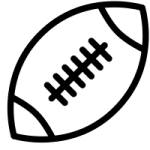Sports Betting Strategies
The Dummies’ Guide to Making Money by Betting on Sports

Sports Betting Explained
What Our Guide Covers:
- The basics: beginners start here
- Sports betting terms you need to know
- Sports betting 101 videos
- Sports betting FAQs
Have a Sport in Mind? Check Out Our Advanced Guides
How Does Sports Betting Work?
If you have ever participated in a props pool for "The Big Game" or a pro football pick'em contest, then you have already stuck your toe into the waters of sports betting. Thanks to the Supreme Court's reversal of the Professional and Amateur Sports Protection Act in May 2018, legalized sports betting in the United States is now open and available to any state that wants to offer it.
Wagering on the four major professional sports began in Nevada turf clubs in 1949. Since then, legalized sports betting has spread from betting parlors, to casinos, to the internet, to phone applications. And you're no longer limited to the four major professional sports. The majority of bookmarkers are now taking bets on everything from college football and basketball, to cricket, to golf, to auto racing, to international soccer.
In its simplest form, there are five types of sports betting wagers: Moneyline bets, spread bets, totals bets, futures bets, and parlay bets. We'll dive into what each of those mean shortly.

How Do You Bet on Sports Online?
With each individual state setting their own rules, online sports betting guidelines vary from state to state. For example, you are allowed to make sports bets anywhere in the state of Nevada, regardless if you are a Nevada resident, but your account must first be set up and funded at a brick-and-mortar sports book. At the moment, Oregon only has one online sports betting application, and it's run by their state lottery. Delaware was the first state outside of Nevada to offer sports betting, yet they do not offer online wagering at this time.
It's important to know what your state, and your surrounding states, offers and what bills are on the table. Want to learn more about sports betting in your state? Check out our 'Where is Sports Betting Legal' guide for more information.
Betting Terms You Need to Know
Understanding Sports Odds: Explained
Walking into a sports book for the first time can be intimidating. Most sports books will have their daily offerings posted in two places: On an odds board, and on printed sheets. The printed sheets are great for circling the games that you are interested in and making some notes, but those sheets are often hours (and sometimes days) old. If you want the most up-to-date information, you need to focus on the odds boards. The odds board will have four key pieces of information that you need to focus on: The rotation number, the point spread, the total, and the moneyline.
How to Read Betting Odds
The rotation number: Sports book ticket writers speak in numbers, not names. If you walk up to the window and ask for $100 on (team name), you will probably be scolded. Most rotation numbers are 3-4 digits and are usually located to the left of the team names on the odds board. Ticket writers rely on that rotation number to eliminate all confusion between themselves and the bettor. Know the rotation number of the game that you are interested in betting.
The point spread: Every football and basketball game will have a point spread associated with it. When looking at the odds board, the favorite will be displayed with a minus sign in front of the spread. That is the number of points that team has to win the game by in order to cover the spread. You won't see a number for the other team, the underdog, because it's understood that they are receiving the same number of points.
The total: You can wager on the "over" or the "under" referring to how many total points will be scored in the contest between both teams.
The moneyline: Moneyline bets are displayed on a $100 scale, with the favorite having a minus displayed in front of their number, and the underdog having a plus in front. Betting on the moneyline means that your team just needs to win the game. There are no point spreads involved.
Understanding Spread Betting
The point spread is the great equalizer. Who would want to bet on a football game between the best team in the league and the worst? The outcome gets a lot more interesting when you give the bad team a 20-point head start. Every football and basketball game will have a point spread associated with it. Betting on the favorite with the point spread requires that team to win the contest by a certain amount of points. Betting on the underdog with the point spread will allow that team to lose the contest, as long as it's not by more than the posted number.
Hockey and baseball also have point spreads, but they work a little different. In hockey (the puckline) and baseball (the runline), the favorite is always -1.5 on the spread with the underdog at +1.5. Betting on the favorite requires your hockey or baseball team to win its game by two or more runs. Conversely, betting on the underdog at +1.5 means that your team can lose by either one run or one goal, and your ticket will still cash.
Moneyline: What is it & How do You Bet on it?
Betting on the moneyline means that your team just needs to win the game. There are no point spreads involved. Moneyline bets are displayed on a $100 scale, with the favorite having a minus displayed in front of their number, and the underdog having a plus in front.
If you are looking to play the favorite on the moneyline, that's the number that you need to lay in order to win $100. If you are betting on a -200 favorite, you need to lay $200 to profit $100, and you would collect $300. If you are betting on the underdog, the number that you see is the amount that you would win off a $100 bet. If you are looking to play a +175 underdog on the moneyline, you would lay $100 to profit $175 and collect $275. Again, there are no point spreads involved, you are simply picking the winner of the game.
The Sports Betting 101 Video Playlist
Check out our full sports betting 101 video playlist.
Sports Betting 101 FAQs
What's the moneyline?
Betting on the moneyline means that your team just needs to win the game. There are no point spreads involved. Moneyline bets are displayed on a $100 scale, with the favorite having a minus displayed in front of their number, and the underdog having a plus in front.
If you are looking to play the favorite on the moneyline, that's the number that you need to lay in order to win $100. If you are betting on a -200 favorite, you need to lay $200 to profit $100, and you would collect $300. If you are betting on the underdog, the number that you see is the amount that you would win off a $100 bet. If you are looking to play a +175 underdog on the moneyline, you would lay $100 to profit $175 and collect $275. Again, there are no point spreads involved, you are simply picking the winner of the game.
What does over/under mean?
You are wagering on how many total points both teams will score in the contest. Pro baseball totals are typically around 9 runs in a game. Pro basketball totals are usually around 210 points. Pro hockey games usually have a total around 6 goals. Pro football totals are typically in the mid-to-upper 40's. You are placing a wager on whether the total points scored between both teams in the contest will go over or under that number.
What does a point spread mean?
Every football and basketball game will have a point spread associated with it. Betting on the favorite with the point spread requires that team to win the contest by a certain amount of points. Betting on the underdog with the point spread will allow that team to lose the contest, as long as it's not by more than the posted number. Hockey and baseball also have point spreads, but they work a little different. In hockey (the puckline) and baseball (the runline), the favorite is always -1.5 on the spread with the underdog at +1.5. Betting on the favorite requires your hockey or baseball team to win its game by two or more runs. Conversely, betting on the underdog at +1.5 means that your team can lose by either one run or one goal, and your ticket will still cash.
What does it mean to cover the spread?
Your team has beaten the mark set by the oddsmaker. If you bet on a -7 favorite to cover the spread in a football game, your team needs to win the game by eight points or more. If they don't, then you failed to cover the spread. If you bet on a +10 underdog in a basketball game, your team can either a) Win the game in an upset; or b) Lose the game by nine points or fewer. If they accomplish either of those things, then you covered the spread.
What does betting against the spread mean?
Betting against the spread goes beyond the simple wins and losses of a sporting event. Betting on the favorite requires your team to win the game by a certain point margin. Betting on an underdog allows your team to lose the game, as long as it's not by more than the given number of points.
What do odds mean in betting?
Odds determine your potential payout on a winning bet. If you're looking to make a single wager against the spread in a football or basketball game, the odds for an individual bet at most sports books are -110. That means that you have to lay $110 to profit $100, and collect $210. You need to lay $11 to win $10, and collect $21. Etc.
But betting odds go well beyond individual wagers. It's important to know what your odds are when making a futures bet on a team to win their championship. It's also important to analyze the odds on parlay bets to make sure that you are getting the best bang for your buck. From parlay calculators to odds conversion charts, there are plenty of tools available for bettors to analyze their odds.
What are good betting odds?
When looking to bet an individual basketball or football game against the spread, you will traditionally have odds of -110. That is the industry standard. In some circumstances, oddsmakers will shade the vig (i.e. the "juice") toward one team to attract some bets toward a certain side and help them balance their books. For example, 3 is a very important number in football because more games finish with a winning margin of 3 points than any other potential outcome. Oddsmakers are very careful with creating point spreads around the number 3 because of how often games end with a 3-point margin. So instead of moving the point spread from -3 to -2.5 or -3.5, oddsmakers will keep the spread at -3 and shift the odds from -110 on each side to -105/-115 or +100/-120.
The reason oddsmakers are so careful with moving the "juice" and not moving the actual point spread is because they don't want to get middled. Middling occurs when groups who bet on the favorite AND the underdog at different point spreads both win. If Group A bets on the favorite at -2.5 and two days later the spread is up to 3.5, Group B swoops in to take the underdog at +3.5. If the game ends 17-14, both groups have just won.
If you are serious about taking sports betting beyond a fun, recreational hobby, it's important to have access to multiple sports books, if possible. Making sure that you are getting the best numbers at the best odds will help you become a profitable long-term bettor.



